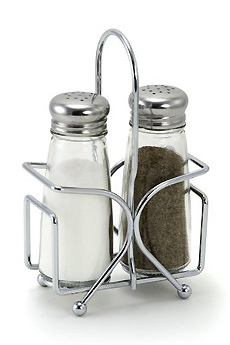TIP OF THE DAY: How To Fill The Salt Shaker
 Shake it up, baby. Salt and pepper shakers and rack from Tablecraft. |
Need to refill the salt shaker but can’t find the funnel? Pouring directly from the box of salt can create a mess. Instead, use an envelope—preferably one of the smaller return envelopes that arrive in the mail. 1. Fill the envelope with the approximate amount of salt that you need. Seal the envelope. 2. Cut off one corner to create a funnel. If you need additional salt, just cut the top off the envelope and add more. 3. When the shaker is filled, place the “funnel” opening in the carton of salt to return any leftovers. Why didn’t we mention filling the pepper shaker as well? You’ll find out in tomorrow’s Tip Of The Day. Which Shaker Gets The Salt? Traditionally, the multiple-hole shaker is for salt and the single-hole shaker is for pepper. The original reasoning is that people want more salt than pepper. But if you find that pepper flows better from the multiple-hole top, feel free to switch. |
|
|
Life Before Salt Shakers Before there were shakers, salt and pepper were served in small ceramic dishes (crystal dishes for the wealthy) called salt cellars. In the kitchen, a wood salt box* was used. Some have two compartments in order to hold both salt and pepper. The word “cellar” doesn’t refer to the basement in this case. It evolved around 1434 from the Anglo-Norman word saler, based on the Old French salier (salt box) and the Latin salarium. Salarium is a great word. There’s more about it below, under Food Trivia. Back to the salt cellars: People would simply take a pinch of salt from the dish. But shakers evolved as a more sanitary option. The gentry used elegant crystal salt cellars (we still have our great-grandmother’s). Presumably, they all washed their hands before coming to the table and pinching the salt and pepper. FOOD TRIVIA For most of the history of the world, salt was a scarce commodity and very costly. Few countries had discovered underground salt deposits, and only those with seacoasts could evaporate salt from seawater. Yet, as it is today, salt was very important for culinary, medicinal and industrial purposes. People even used it as currency: One of our favorite books is Salt, A World History, by Mark Kurlansky. It’s a page-turner.
|
||